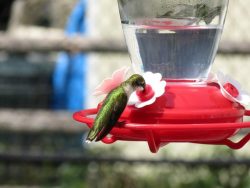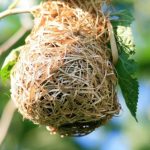Hummingbird feeders may be readily hung in a variety of locations across the yard. While every yard, garden, and landscape is unique, some of the best places to put hummingbird feeders include:
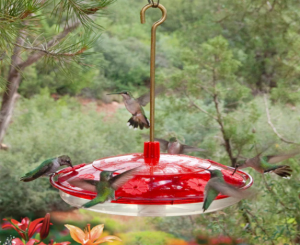
- Use in a flowerbed with nectar-producing flowers a shepherd’s hook or a freestanding arbor as gorgeous support for a flowerbed hummingbird feeder.
- The window is one of the simplest ways to begin feeding hummingbirds. This will provide you with excellent views while also ensuring the safety of the birds. Window hummingbird feeders use suction cups to cling to your window and attract hummingbirds.
- From a gutter, awning, or roofline above. This may provide hummingbird feeders with simple midday shade, allowing the nectar to last longer.
- Within ten to fifteen feet of a safe location. Hanging feeders near a brush pile or thick foliage will provide a safe haven for these vulnerable birds if they feel threatened.
- From an extending arm on a deck railing. Specialized hangers may be attached to a deck railing for easy hanging in a location where the feeders can be seen and reached.
- If you’re hanging your hummingbird feeder from a tree, find a stem that enables you to hang the feeder at least 5 feet above the ground and is out in the open. To avoid damaging the tree, wrap a piece of twine, thread, wire, or even a coat hanger around the stem and hang the feeder from it.
Should the Hummingbird Feeder Hang High or Low?
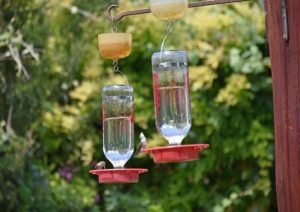
Hummingbird feeders should be placed or hung at a height of 4-6 feet in the middle of the yard. The safest position is up to 6 feet, but any higher is OK as long as you have access to the feeder.
If you hang the hummingbird feeder at 4 feet or below, it will be available to everyone, so keep it high. If you have a quiet space to spare, try this since hummingbirds will love a position that is thought too low or high if they can at least get there without being disturbed around the clock.
In fact, a hummingbird feeder can never be hung too high since it is higher up and away from humans, dogs, and predators that might kill the delicate hummingbirds.
With that in mind, a minimum height of 4 feet is required, but any higher is preferable. Hanging, sitting, or putting the hummingbird feeder too low to the ground, where it is within reach of pets, nuisance animals, and even children, maybe a mistake.
The feeder must not be placed below 4 feet, although you should maintain it considerably higher than that.
Buy a New Hummingbird Feeder From Amazon Here
How Do I Attract Hummingbirds To My Feeders?
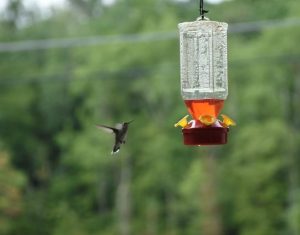
Most hummingbird feeders now have enough red on them to attract them. Red and other bright shades attract them because they resemble flowers that provide nectar. You may put red ribbons on your feeders to attract hummingbirds for the first time, which will aid in their detection.
Plant Red Flowers
Bright red flowers with a tubular form are best suited for hummingbird pollination in North America. Hummingbirds are attracted to red colors and investigate them immediately.
Provide a variety of natural nectar plants to provide protection and attract the little insects that hummingbirds eat.
Offer Sugar Water
Hummingbirds need to be fed regularly since they expend their energy extremely fast. Nectar feeders are a common alternative for attracting these birds. You may simply make your own.
Measure out 1 part white sugar to 4 parts water and stir well. If you boil the mixture to eliminate impurities, it may last longer before it begins to degrade. Simple sugar and water will work just fine to attract hummingbirds.
Keep Feeders Clean
Sugar water that has begun to turn moldy may be hazardous to birds. If you’re going to set out feeders, it’s crucial that you keep them clean and refill the mixture regularly—at least once every three or four days, more frequently in warmer weather.
If the mixture begins to seem murky, clean the feeder and replace the nectar immediately.
Buy a New Hummingbird Feeder From Amazon Here
Place Feeders in the Same Place as Last Year
If the hummingbirds returning in spring seem to remember where you had flowers or feeders in previous years, they probably do.
As tiny creatures that rely on specialized food sources in a big, big world, they have to be good at finding their way back to the best spots.
They have a highly developed sense of what scientists call spatial memory. This is a good reason to work extra hard at attracting hummingbirds.
New and Innovative Feeder!
A brilliant new protein feeder has come up lately called the “Humm-Bug Insect Feeder,” a great invention that holds banana peels to attract insects that eat the peels. If the feeder is placed near nectar feeders, hummingbirds will also have insects along with nectar accessible!
How Long Until Hummingbirds Find My Feeder?

It’s rare that you are going to install a feeder or put a few flowers and immediately hundreds of hummingbirds emerge. It might take days, weeks, or months before hummingbirds notice your yard and start coming frequently.
Each area in North America has a distinct time period for hanging hummingbird feeders. Hummingbird feeders should be hung two weeks before the predicted arrival date.
Study prior years’ hummingbird migration dates in your location to predict when they will arrive. The hummingbird migration starts in February in the southern United States and concludes in late May in Canada.
The arrival of the hummingbirds in the spring after their long, difficult flight appears to us to be a miracle. You can get an idea of when they’ll arrive by looking at the migration website.
After you know the projected arrival date, hang your feeders two (2) weeks before the estimated arrival date. It has been observed that in certain years hummingbirds have returned sooner than years before.
Why Won’t Hummingbirds Drink From My Feeder?
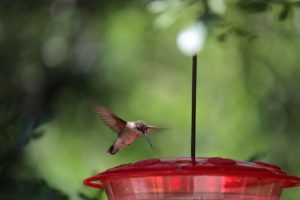
The feeders are unclean or the nectar has expired. The sugar in the hummingbird meal may quickly degrade if left out in the sun too long.
The birds could be so acclimated to the previous feeder in a given area that they would be more tolerant of a new feeder in a new position.
Generally, two factors keep hummers away from feeders: the difficulty of locating them or distaste for the nectar.
Hummingbirds are not coming to you feeder for one or more of the following six reasons:
- Unattractive hummingbird oasis,
- Impossible to find the feeder,
- Fermenting hummingbird nectar,
- Bees on the feeder,
- Seasonal migrants,
- Presence of potential predators.
How Can I Attract Hummingbirds to My Yard and Provide a Safe Nesting Place?
To attract hummingbirds to your yard and create a safe nesting place, there are several ways to attract hummingbirds you can try. Start by providing a variety of nectar-rich flowers and plants, such as trumpet vine or bee balm, along with feeders filled with sugar water. Adding a water feature like a birdbath or misting fountain can also help. Ensure there are perches and shelter nearby, while avoiding pesticide use. By implementing these ways to attract hummingbirds, you’ll create an inviting environment for them to thrive and nest.
Should Hummingbird Seeders Be In Sun or Shade?
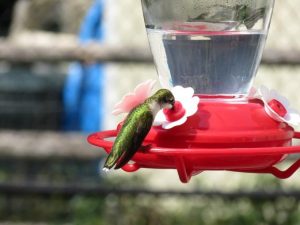
Hummingbird nectar might go bad more rapidly if the feeder is hanging in the sun all day. Sunshine striking a hummingbird feeder will rapidly generate white, misty nectar that won’t be consumed by hummingbirds since the flavor and quality are no longer present.
However, there are also strong reasons for situating your hummingbird feeder such that it does catch some light throughout the day.
Hummingbird feeders should not be placed in the sun because liquids in a hummingbird feeder will only become a maximum of roughly 10 degrees Fahrenheit warmer than the surrounding air temperature.
The most essential reason for maintaining the hummingbird feeder in the shade is to make the hummingbird food last longer without rotting.
That sugar water in the sun may soon produce colonies of germs and mold. Bacteria typically manifest as murky hummingbird nectar.
Hummingbird feeders need to be in the shadow to counterbalance the sunlight during the summer or when it is hot outside.
It is not at all feasible to hang or position a hummingbird feeder for a complete day in the sun when shade is required at the earliest time.
Buy a New Hummingbird Feeder From Amazon Here
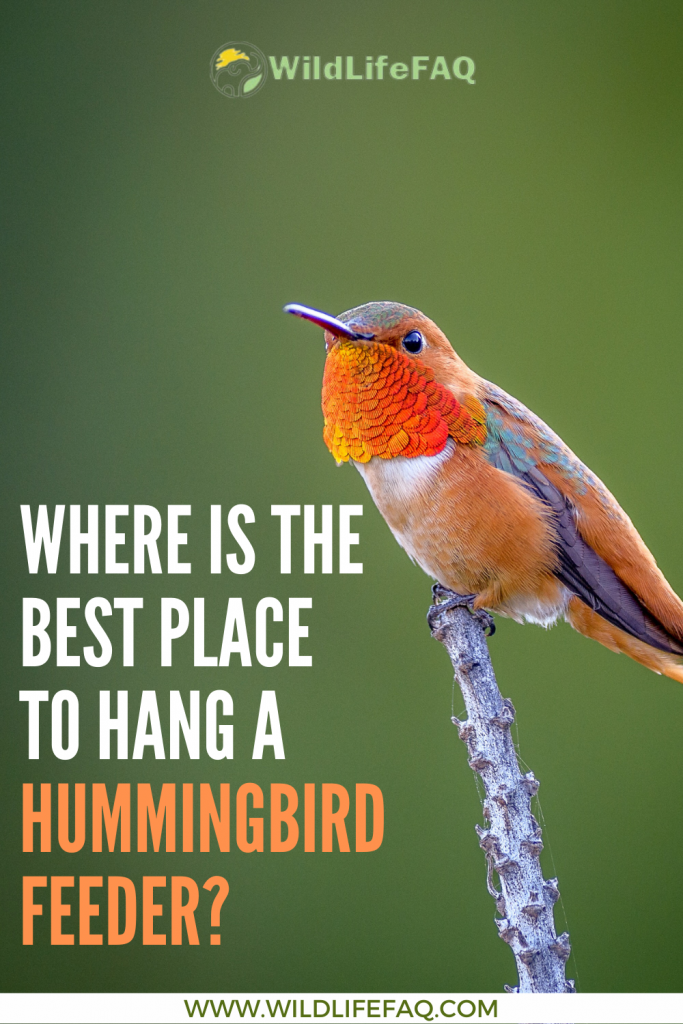
Keywords: Nector feeders; Humm-Bug Insect Feeder; Sugar water

